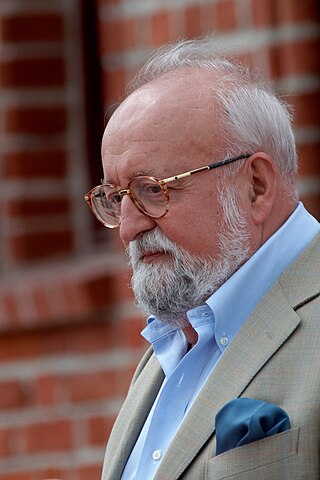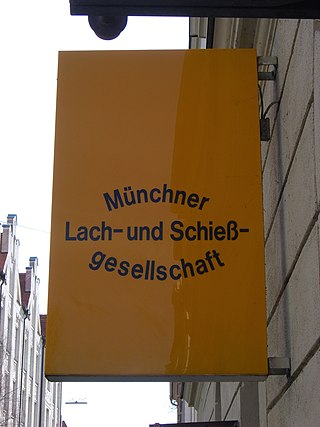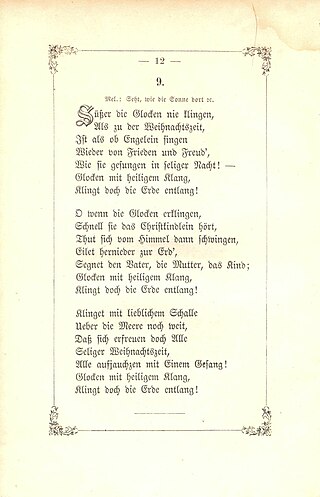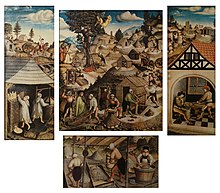
Reinhard Friedrich Michael Mey is a German Liedermacher. In France he is known as Frédérik Mey.

The Ebers Papyrus, also known as Papyrus Ebers, is an Egyptian medical papyrus of herbal knowledge dating to c. 1550 BC. Among the oldest and most important medical papyri of Ancient Egypt, it was purchased at Luxor in the winter of 1873–1874 by the German Egyptologist Georg Ebers. It is currently kept at the Leipzig University Library in Germany.

An die ferne Geliebte, Op. 98, is a composition by Ludwig van Beethoven written in April 1816, setting poetry by Alois Jeitteles.
Hans-Friedrich Blunck was a German jurist and a writer. In the time of the Third Reich, he occupied various positions in Nazi cultural institutions.

Michael Holm is a German singer, musician, songwriter and record producer. He is primarily known as a singer of Schlager music. Although his first appearance in the hit parade was in 1962, he had his first big hit in 1969. "Mendocino", the German adaptation of a song by the Sir Douglas Quintet, was the biggest selling single that year in (Germany). The record was released in September 1969, reached number three for five weeks, selling over a million copies. Ariola presented him with a gold record in October 1970.

Ireen Sheer is a German-English singer. She had her first major hit in 1970 with Hey Pleasure Man. She had a top five hit on the German singles chart with "Goodbye Mama" in 1973. She went on to finish fourth at the Eurovision Song Contest 1974 representing Luxembourg, sixth at the Eurovision Song Contest 1978 representing Germany, and thirteenth at the Eurovision Song Contest 1985 representing Luxembourg again.

Johann Peter Theodor Janssen was a German historical painter.

The Symphony No. 8 "Lieder der Vergänglichkeit" by Krzysztof Penderecki is a choral symphony in twelve relatively short movements set to 19th and early 20th-century German poems. The work was completed and premiered in 2005. The symphony has an approximate duration of 35 minutes. Penderecki revised the symphony in 2007 by adding a few more poem settings and the piece has expanded to around 50 minutes. Although given the designation Symphony No. 8, it was not actually the final symphony Penderecki completed before his death in March 2020; the Sixth Symphony, begun in 2008, was not completed until 2017.
The Leipzig Book Fair Prize is a literary award assigned annually during the Leipzig Book Fair to outstanding newly released literary works in the categories "Fiction", "Non-fiction" and "Translation". The Leipzig Book Fair Prize has been awarded since the Deutscher Bücherpreis was ceased in 2005, and is one of the most important literary awards in Germany. The winner in each category is awarded €15,000.

The Upper Harz is the northwestern and higher part of the Harz mountain range in Germany. The exact boundaries of this geographical region may be defined differently depending on the context. In its traditional sense, the term Upper Harz covers the area of the seven historical mining towns (Bergstädte) - Clausthal, Zellerfeld, Andreasberg, Altenau, Lautenthal, Wildemann and Grund - in the present-day German federal state of Lower Saxony. Orographically, it comprises the Harz catchment areas of the Söse, Innerste and Grane, Oker and Abzucht mountain streams, all part of the larger Weser watershed.
Volkslied is a genre of popular songs in German which are traditionally sung. While many of them were first passed orally, several collections were published from the late 18th century. Later, some popular songs were also included in this classification.
Wolfgang Amadeus Mozart displayed scatological humour in his letters and multiple recreational compositions. This material has long been a puzzle for Mozart scholarship. Some scholars try to understand it in terms of its role in Mozart's family, his society and his times; others attempt to understand it as a result of an "impressive list" of psychiatric conditions from which Mozart is claimed to have suffered.
Peter-Huchel-Preis is a literature prize awarded in Baden-Württemberg, Germany. The Peter Huchel Prize for German-language poetry, donated by the state of Baden-Württemberg and Südwestrundfunk, has been awarded since 1983 for an outstanding lyric work of the previous year. The award is endowed with €10,000 and is presented annually on 3 April, Peter Huchel's birthday, in Staufen im Breisgau.
Ernst Ottwalt was the pen name of German writer and playwright Ernst Gottwalt Nicolas. A communist, he fled Nazi Germany in 1934 and went into exile in the Soviet Union, where he fell victim to the Great Purge and died in a Soviet gulag. Later, when the Allies of World War II prosecuted Nazi war criminals in the Nuremberg Trials, the chief prosecutor from the Soviet Union quoted from an anti-Nazi book by Ottwalt.

Wo Gott der Herr nicht bei uns hält, BWV 178, is a church cantata by Johann Sebastian Bach. He composed it in Leipzig for the eighth Sunday after Trinity and first performed it on 30 July 1724.

A miner's habit is the traditional dress of miners in Europe. The actual form varies depending on the region, the actual mining function, and whether it is used for work or for ceremonial occasions.

The Mooskappe is an old, traditional miners head covering. It was intended to protect miners when working underground from the impact of small rockfalls and from hitting their heads against the gallery roof (Firste). The term is German and this type of hat was worn especially in the Harz Mountains of Germany.

"Nun freut euch, lieben Christen g'mein", or “Dear Christians, One and All, Rejoice” in English, is a Lutheran hymn, written in 1523 by Martin Luther. It is one of Luther's early hymns and considered by some as one of his finest. It was published as one of eight songs in 1524 in the first Lutheran hymnal, the Achtliederbuch. The Achtliederbuch contained four songs by Luther, three by Speratus, and one by Justus Jonas. It appeared also in 1524 in the Erfurt Enchiridion.

The Münchner Lach- und Schießgesellschaft is a German political kabarett that runs at its own theatre in Schwabing, Munich. It was founded in 1956 by journalist Sammy Drechsel and comedian Dieter Hildebrandt, who were soon joined by Klaus Peter Schreiner. Walter Kabel was responsible for the show's music from 1956 to 1972, which included his own compositions.

"Süßer die Glocken nie klingen" is a popular German Christmas carol with text by Friedrich Wilhelm Kritzinger to a traditional Volkslied melody, first printed in 1860. It has remained popular and is part of many song books and Christmas recordings, evoking the sound of bells as a symbol of peace and joy.
















